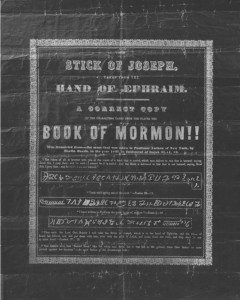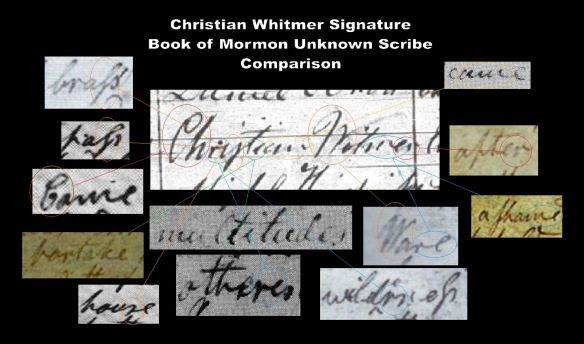Joseph Smith Jr claimed that the original version of the Mormon Bible was made by the (otherwise unknown to history) “Nephite” people. Using a language he called “reformed Egyptian”, they engraved it onto a set of gold plates, and then buried them underground. In 1823, the Angel Moroni revealed the location of these plates to Smith (though, the story goes, Smith didn’t actually dig them up until 1827), effectively bringing the Mormon Church into being.
In February 1828, Smith’s early follower Martin Harris (a local farmer) travelled to New York with a transcript of some odd-looking letters to show to well-known Classical scholar Professor Charles Anthon. However, Anthon quickly became convinced that the farmer was being scammed, told Harris this, and refused to authenticate the document. Anthon later described what happened (together with his reactions and conclusions at the time) in two three letters from 1834, 1841, and 1844, with the key descriptive section from the 1834 letter reading:-
This paper was in fact a singular scrawl. It consisted of all kinds of crooked characters disposed in columns, and had evidently been prepared by some person who had before him at the time a book containing various alphabets. Greek and Hebrew letters, crosses and flourishes, Roman letters inverted or placed sideways, were arranged in perpendicular columns, and the whole ended in a rude delineation of a circle divided into various compartments, decked with various strange marks, and evidently copied after the Mexican Calendar given by Humboldt, but copied in such a way as not to betray the source whence it was derived. I am thus particular as to the contents of the paper, inasmuch as I have frequently conversed with my friends of the subject, since the Mormonite excitement began, and well remember that the paper contained any thing else but “Egyptian Hieroglyphics.”
Unfortunately, no document fitting this description has ever been found. However…
The Interpretation of the Book
A handful of mysterious-looking characters were written (“and kept for profit and learning”) by two early Church of the Latter Day Saints members. Firstly, by Oliver Cowdery (figure 3a in MacKay et al 2013):
Secondly, by Fredrick G. Williams, who specifically wrote circa 27th February 1836 (Church History Library) that these were “characters on the Book of Mormon” (figure 3b in MacKay et al 2013):-
What makes these two (reasonably) credible witnesses is that they were both scribes for Joseph Smith in the very early years of the Mormon Church (e.g. Williams joined the Church in 1830) – that is, Smith dictated the Book of Mormon while his scribes wrote it down.
Were these four shapes part of the same document that was shown to Charles Anthon? Structurally, they resemble shapes taken from a single example of the kind of tachygraphic shorthand system that was very popular at the time; whereas what Martin Harris showed Anthon sounds instead much more like a multi-alphabet “mash-up”. It is, of course, hard to be sure that these are not in some way part of the same thing: but the many differences do seem quite substantial, and remain unexplained in any reasonable way.
However, given that all we know of this particular writing system is that it contains these four shapes, it will (unless someone matches it to a known shorthand system) remain unreadable.
Caractors
Independently of the above, there is a separate fragmentary page of “Caractors” dating from early on in the Mormon Church’s history that has also been widely claimed to have been taken from the writing of the original Book of Mormon. Here is an image of it:
The fragment depicted here is still extant: a recent test carried out on it reported by MacKay et al showed that the “Caractors” lettering at the top and the lettering of the curious letters were all done in the same ink, and presumably by the same person. However, Mackay et al also demonstrated major differences between the ‘Caractors’ lettering and the prophet Joseph Smith Jr’s handwriting, so suggestions that Smith wrote or copied this down himself are almost certainly incorrect.
Parts of the same curious text were reproduced in an 1844 broadside promoting the Book of Mormon. This was printed in gold on black stock: an image of it appears in MacKay 2013, though with some parts of the image rotated, presumably by accident rather than by Divine command (Figure 2):
A close-up of the text from the same image (MacKay 2013, Figure 2a):
Note that even though there are lines of text from the Bible interspersed between the lines of mysterious text here (e.g. “Truth shall spring up out of the earth”), it seems very unlikely that these are intended to be taken as translations of the curious text.
The same three lines of mysterious text were printed in The Prophet in December 1844, but rotated (possibly to better match the “perpendicular columns” Charles Anthon described in 1828).
“We have published a very neat specimen of the original characters on hieroglyphics that were copied from the plates which the book of Mormon was translated from, and were presented by Martin Harris to professor Anthon for translation. We have been to some trouble in having it engraved by Mr. Strong: one of the most skillful engravers in the city of New York; those who wish to obtain a copy to preserve as a memorial, can procure them by applying to the Prophet Office New York.”
Up until a few years ago, this was the total of what was known. However, in 2012 a photograph was uncovered in Clay County Museum in Missouri by ‘Grindael’ that had been taken by local photographer Jacob T. Hicks in 1884 or so. Scans of the Clay County Museum’s photographs are here and here.
Provenance
Grindael points out – via P. William Poulson, a somewhat unreliable witness – that there is some evidence that John Whitmer was in possession of the ‘Caractors’ page for many year up until 1878, when they passed to David Whitmer.
Then, according to Improvement Era, January 1942, p. 58 (quoted by Grindael on a particularly detailed page covering this topic):
After David Whitmer’s death, these items were passed to his son, David J. Whitmer, along with John Whitmer’s Church History and OTMan 3. This collection of documents were eventually given into the care of George Schweich, a nephew of David J. Whitmer, who subsequently sold them to the RLDS Church for $2450 in 1903
A century later, the Caractors fragment is still in the LDS archive.
In the many interviews David Whitmer did between 1878 and his death in 1888, he repeatedly asserted that this was the “original paper” that Martin Harris had taken to Charles Anthon back in 1828, despite the numerous obvious differences. Grindael notes that the bottom part of the fragment was almost certainly “torn off sometime before 1884, because it is described as having the same dimensions then as it did in 1903.” The text visible on the bottom half (“The Book of Generation Adam”) can probably be dated (as MacKay et al point out) to 1830, when the phrase “The Book of Generation Adam” began to be widely used within the Mormon Church.
Hence Grindael goes on to suggest that the bottom part may well have was torn off because its presence would straightforwardly invalidate David Whitmer’s claim that this was the same document that Martin Harris took to Professor Anthon.
Who Wrote This?
If this was not the original copy of the ‘Caractors’ and Joseph Smith did not write them down, then who did? MacKay et al propose (at some length) that John Whitmer was the writer, but the handwriting match they propose is far from perfect.
Royal Skousen pointed out in 2013 (a video of him is linked to by in Grindael’s final page) that we should not forget that there was another Whitmer involved as an amanuensis for Joseph Smith Jr in the early days: Christian Whitmer.
Grindael helpfully includes this composite image of Christian Whitmer’s handwriting:
This seems a much more satisfactory match than John Whitmer’s handwriting (Brent and Erin Metcalfe agree, based on their analysis of other writing by Christian Whitmer). But even so, this is unlikely to be the final word on the subject.
Bibiography
MacKay, Michael Hubbard; Dirkmaat, Gerrit J.; Jenson, Robin Scott. The “Caractors” Document: New Light on an Early Transcription of the Book of Mormon Characters – Mormon Historical Studies, vol. 14, No. 1.







